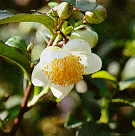HOME PAGE

CAKE & SNACK
Kastella

Dorayaki

Kompeitoh

DRESSING

GARDENING

GREEN TEA
Varieties

Preparation

When
and where

Benefits

PICKLES
Beer-zuke

Hakumai-zuke

Bettara-zuke

NATTO

SUSHI
Rice

Nigiri-zushi

Hako-zushi

Temaki-zushi

Masu-zushi

 A flower of the tea plant, "Camellia Sinensis,"
which is a relative of the well known camellia plants.
They can not be grown in cold areas. Ibaraki and Saitama
prefectures (about 100 miles north of Tokyo) are about the north
bounds for growing tea in Japan.
The tea trees are cultivated to be a few feet tall, but
if left untrimmed, they can grow up to ten yards high.
A flower of the tea plant, "Camellia Sinensis,"
which is a relative of the well known camellia plants.
They can not be grown in cold areas. Ibaraki and Saitama
prefectures (about 100 miles north of Tokyo) are about the north
bounds for growing tea in Japan.
The tea trees are cultivated to be a few feet tall, but
if left untrimmed, they can grow up to ten yards high.
Tea Varieties
Difference between green tea, oolong tea and black tea:
- All three are produced from the same tea specie,
but the processes are different.
Green tea is prepared from fresh leaves or buds that are
steamed, then rolled and dried. Wilting the fresh leaves in the sun
and partially fermenting them make oolong. The fermentation of oolong is
stopped by roasting in an oven.
Fully fermenting the slightly wilted leaves makes black tea.
- Sencha
Most popular kind of tea in Japan. Made from the leaves exposed to direct sun lights. The price changes widely from low to high. High-priced senchas use young, small and tender leaves, while low-priced sencha leaves use older, larger and harder leaves. Accordingly the tastes change. The high-priced senchas have a deep aromatic taste with some sweetness. The low-priced sencha tend to have a stronger bitterness but less flavor. For serving, boiled water cooled 80 degrees C should be used for preparing tea (see "Preparation" ).
- Gyokuro
Made from the young leaves that are protected from the sun light for two weeks before plucking (footnote 1). Gyokuro has a dark green color. The tastes are sweeter and much milder than sencha. Boiled water cooled to 70 to 75 degrees C should be used for serving Gyokuro (see "Preparation" ).
- Matcha
Powder made from buds protected from the sun. Used for tea ceremony. Mixed also in icecream, liquor, snacks, and cakes. Someone even invented green tea Tilamisu (see footnote 2).
- Bancha
Made from grown-up tea leaves plucked in late summer or autumn. Inexpensive.
- Houjicha
Roasted tea, made from bancha in most cases, but sometimes from sencha.
Footnote
-
(1) Tea plants to produce gyokuro:
http://www.chabashira.co.jp/meetinshz/scbEng/5e/toka1e.html
(2) To find more about green tea Tilamisu:
http://starchefs.com/NMatsuhisa/tiramisu.html
http://w3.vit.or.jp/~murataen/english/mura112.html (variety of japanes tea)
http://www.naranoshi.pref.nara.jp/tea/process.html (tea production: You need Japanese fonts to read this page.)
http://www.inh.co.jp/maru7/qa/qa.html (other varieties of tea: yabukita, fukamushi. Japanes fonts required.)
http://www.chabashira.co.jp/meetinshz/scbEng/5e/moka1e.html (sightseeing) http://www.culture-dome.or.jp/FS-E/NUMBERS/FS19/page01-e.htm (general info.)
http://www.moa.or.jp/english/naturefarm/nf-chap2.html (tea production)